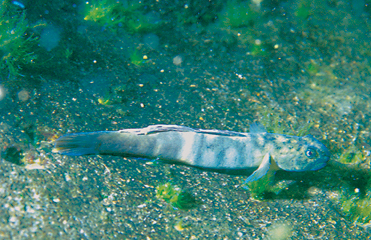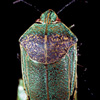 |
9.
O`opu alamo`o / o`opu hi`ukole
Five species of native 'o'opu occur in streams in the Hawaiian
Islands. Four species (Stenogobius hawaiiensis, Awaous guamensis,
Lentipes concolor, and Sicyopterus stimpsoni) are in the
family Gobiidae (gobies) and one species (Eleotris sandwicensis)
is a member of the family Eleotridae (sleepers). Hawaiian 'o'opu
have recently been reclassified: four species are now considered endemic,
and one species 'o'opu nakea (A. guamensis) is considered
indigenous (found in Hawai`i and elsewhere in Polynesia).
'O'opu have an amphidromous life cycle; they migrate to and from
the sea but do not use the ocean for reproduction. 'O'opu spend
their entire adult lives in freshwater streams. They reproduce in the
stream, laying their eggs on the upper surfaces of rocks and hatch within
48 hours. Larvae then drift out to the ocean and spend up to 160 days
in a planktonic state. Returning post-larval 'o'opu, called hinana,
may ascend randomly to streams and at times in great numbers.
Species such as 'o'opu nakea, 'o'opu nopili (S. stimpsoni),
and 'o'opu hi'ukole (L. concolor -- pictured here) are capable
of climbing waterfalls and areas of rapids. 'O'opu hi'ukole is
the strongest climber and is capable of ascending very large waterfalls.
Individuals have been reported to ascend single waterfalls as high as
1000 ft.
'O'opu nakea is known to migrate downstream to spawn on riffles
located just upstream of the ocean. Downstream spawning runs are believed
to be triggered by the first large rainstorm in the fall. However, postlarvae
have been found throughout the year, indicating that some degree of spawning
occurs throughout the year.
A major ecological requirement for 'o'opu is the need to pass through
a stream mouth at 2 times during the individual's life. The most important
factor for the existence of endemic 'o'opu in streams is that access
to and from the ocean is maintained. Stream channelization and diversions
can eliminate or significantly limit native fish populations within a
stream.
'O'opu hi'ukole was listed as a Candidate species on the Federal Register,
and was considered 'threatened' by the American Fisheries Society (AFS).
'O'opu nakea and 'o'opu nopili were considered to be species
of special concern by the AFS.
|

 GOOD GUYS & BAD GUYS
GOOD GUYS & BAD GUYS 


 GOOD GUYS & BAD GUYS
GOOD GUYS & BAD GUYS 


